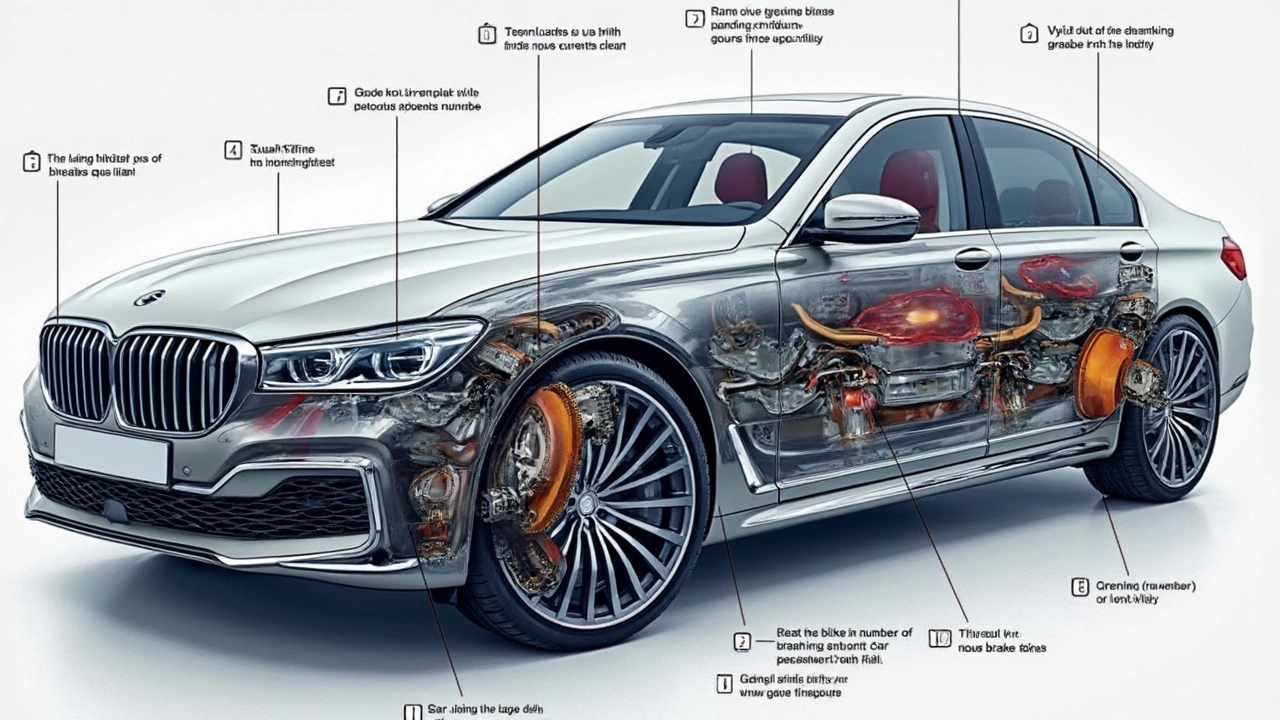So you're in the driver's seat, cruising down the highway when it hits you—do you need 4 or 8 brake pads? If this question's got you scratching your head, you're definitely not alone. Knowing the answer is crucial, not just for your peace of mind but also for your car's safety.
Let’s kick off by talking about how brake pads work. In most vehicles, you have a pair of brake pads for each wheel. These pads squeeze against the brake disc to create friction and eventually slow the car down. So, the more pads in play, the more stopping power you've got. But, not all cars use the same setup.
Now, here's where it gets interesting: Many cars today have what's called disc brakes on both the front and rear wheels, meaning you'd have 8 brake pads altogether—two for each wheel. But some vehicles, especially older ones or certain models, use disc brakes only on the front wheels and drum brakes at the rear. These setups require fewer brake pads, just 4, for the front wheels alone.
- Understanding Brake Pad Basics
- Types of Braking Systems
- How Many Brake Pads Do Cars Need?
- Signs You Need New Brake Pads
- Choosing the Right Brake Pads
- Brake Pad Maintenance Tips
Understanding Brake Pad Basics
Alright, let's get into what makes those brake pads tick. At the core of it, brake pads are one of the most vital components of your car's braking system. Their main job? Creating the friction needed to stop your car. When you press the brake pedal, these pads squeeze together against a rotor to slow down the wheels.
Brake pads are made from different materials, each with its own perks. You've got organic brake pads, semi-metallic, and ceramic. Organic ones are quiet but wear out fast. Semi-metallic pads are sturdy and handle heat well but can be a bit loud. Ceramic pads, meanwhile, blend longevity and quiet operation, though they can be a little pricey.
Russell Shepherd, an engineer at a major automotive company, puts it simply:
"Your brake pads are where stopping the car starts. Choose wisely, and they'll give you that much-needed peace of mind every time you're on the road."
Now, onto how these pads are arranged. A typical setup for newer vehicles includes four brake pads at the front and another four at the rear, thanks to disc brakes on all wheels. But if you've got an older model or a specific type of car, you might find drum brakes in the rear, meaning fewer pads—a good thing when it comes to replacements, but something to consider in terms of performance.
| Type of Brake Pad | Key Characteristics |
|---|---|
| Organic | Quiet, wear out faster |
| Semi-Metallic | Durable, heat-resistant, can be noisy |
| Ceramic | Long-lasting, quiet, higher cost |
The differences in materials not only affect performance but also price and maintenance. So, when you're picking new ones, it’s essential to weigh the pros and cons based on how you drive and what you're comfortable spending.
Types of Braking Systems
Hey, if you’ve ever wondered what’s making your car stop (besides your foot), it boils down to the braking systems. There are a few main types, but they basically all do the same job—keeping you safe and in control.
Most cars on the road today use disc brakes. You’ve probably heard of these, right? They work super efficiently, using brake pads to squeeze a rotor attached to each wheel. This setup gives you lots of stopping power and is super reliable in all kinds of weather. They cool down quickly too, which is a nice plus when you're driving around the city or braking a lot on highways.
Next on the list is the drum brake. Not as common on newer cars, but you’ll still find them on many vehicles, particularly on the rear wheels. Drum brakes have shoes that press outwards against the inside of a spinning drum. They’re usually cheaper and last longer, but they don’t cool down as quickly as disc brakes.
And then there's the combo setup: disc brakes in the front (for that critical stopping power) and drum brakes at the back. This mixed system is pretty common because it balances costs with performance. Cars usually need stronger brakes at the front since that's where most of the stopping force happens.
For those who love data, here’s a quick look at how these systems compare in certain aspects:
| Brake Type | Cooling Efficiency | Cost | Maintenance Frequency |
|---|---|---|---|
| Disc Brake | High | Moderate to High | Moderate |
| Drum Brake | Low | Low | Low |
| Disc & Drum Combo | Moderate | Moderate | Moderate |
So there you have it! Understanding these braking systems can really help you make the best call when you're all set to swap out those brake pads or even when you're thinking about your next set of wheels.
How Many Brake Pads Do Cars Need?
Alright, let’s unravel this brake pad mystery. In most modern cars, you’re looking at needing 8 brake pads in total. Why 8? Well, that’s because each wheel typically gets a pair of pads to grip the brake disc effectively. Think of it like two strong hands working together to make sure your car stops when you need it to.
However, not all cars are built the same. Some older models or specific types of vehicles might use a combination of disc and drum brakes. These older setups usually have disc brakes only on the front wheels. So, you would only need 4 brake pads for the front wheels, while the rear wheels rely on drum brakes, which work differently.
And then there's the performance aspect. High-performance vehicles, like sports cars, often have more advanced braking systems. These might include additional pads or specialized pads designed to withstand higher temperatures and provide greater stopping power. It can be a bit more complex, but the basic rule remains: most cars need either 4 or 8, depending on their brake system setup.
- Disc brakes: Typically 1 pair per wheel (so 8 for a car with disc brakes on all four wheels).
- Drum brakes: No pads are involved, but they have shoes instead.
- Mixed systems: Usually 4 pads for the front, if the rear uses drums.
Knowing your car's brake system and how many brake pads it requires isn't just about maintenance; it’s essential for your safety on the road. If you’re ever unsure, a quick peek in your vehicle’s manual or a chat with your mechanic can clear things up.

Signs You Need New Brake Pads
Alright, you've been driving for a bit, and suddenly you're noticing something off about your ride. Could it be your brake pads? Here are some telltale signs that you might need to invest in a fresh set.
Squealing and Screeching: This is the number one red flag. If your brakes are making a lot of noise when you stop, it's a good sign they've worn down. Most pads have a built-in wear indicator that starts to squeal as it gets thin. This noise is like your car shouting, "Hey, replace these pads!"
Longer Stopping Distance: Have you noticed it takes longer for your car to come to a complete stop? That's not just annoying; it's dangerous. It means your brake pads are on their last legs and can't create the friction necessary for safe braking.
Pulsation or Vibration: If your brake pedal vibrates when you press it, you might have warped rotors, which often results from worn-down brake pads. It's not something you'd want to ignore since it can damage your braking system further.
Thin Brake Pads: Take a quick look through your wheel spokes. If the pads look less than a quarter-inch thick, it’s time for a change. Thin pads won't last long and won't stop your car as efficiently.
These symptoms are pretty hard to ignore, and thankfully, they usually appear before any major system failure. If you're spotting more than one sign, make sure to consult a mechanic who can give you a heads-up on your next steps. Staying on top of vehicle safety is key to keeping your drive smooth and your peace of mind even smoother.
| Sign | Indication |
|---|---|
| Squealing Noise | Brake pads are worn |
| Longer Stopping Distance | Brake pads losing efficiency |
| Vibration | Possible warped rotors |
| Thin Pads | Less than 1/4 inch thick |
Choosing the Right Brake Pads
Picking the right brake pads isn't just about heading to the store and grabbing the first set you see. There's a bit more to it, but don't worry, it's totally something you can handle. The key is understanding your driving style and what you need from your car's braking system.
First off, let's talk about material. Brake pads come in different types, including ceramic, semi-metallic, and organic. Each has its pros and cons:
- Ceramic brake pads: These are a popular choice because they're quiet and don't produce a lot of dust. They're generally good for everyday driving but might not handle extreme driving conditions as well.
- Semi-metallic brake pads: These pads are durable and provide strong stopping power, making them a great option if you do a lot of high-speed driving or if you're towing. However, they can be a bit noisy.
- Organic brake pads: These offer smooth and quiet stopping but wear out faster and might not be ideal if you're rough on your brakes.
Now, think about what you're going to use your vehicle for. Got a sporty car that you're taking to the track? You'll need something like the semi-metallic kind. Just driving to work and back? Ceramic could be your best bet.
And here's a fun fact: if you're really stumped, check your car's manual. Automakers know their stuff when it comes to suggesting the ideal type of brake pad for your vehicle.
Oh, and don't forget about price. While it can be tempting to go for the cheapest pads available, remember the saying, "you get what you pay for." Investing in a quality set can save you money and give you peace of mind down the road.
One last thing to keep in mind is fit. Brake pads come in specific shapes and sizes for different vehicles, so confirm the right match for your car's make and model. No one wants to deal with a return trip to the parts store.
Brake Pad Maintenance Tips
Keeping your brake pads in top shape is key to your car's safety and longevity. You've got to be proactive, but don't worry—it's not rocket science. Here’s how to keep those crucial components working like they should.
First up, give your pads a regular look-over. A good rule of thumb is to check them every 10,000 miles or once a year, whichever comes first. Keep an eye out for uneven wear, deep grooves, or pads that are thinner than 3mm—these are all red flags.
Next, get into the habit of listening. No, really—press those brakes and listen. If you hear any squealing or grinding sounds, that's your cue to have a professional take a look. Ignoring these sounds might mean paying more down the line.
Let’s talk cleaning. Brake dust can build up, leading to poor braking performance. So, it's a good idea to clean your wheels periodically. A simple rinse with water and a non-abrasive cleaner will work wonders.
Here’s a handy tip: try to avoid hard braking unless it's an emergency. It saves wear and tear on your brake pads and can extend their lifespan. Gentle braking helps keep things smooth and steady.
Now, if you're feeling adventurous and want to change the pads yourself, go for it! Just make sure you're using the right kind of pads for your ride and always follow the installation instructions to the letter.
Lastly, don't forget about the brake fluid. If you’ve ever noticed your brakes feeling spongy, it might be time for a fluid check. While you're at it, look for any leaks in the brake line—better to catch those early.
Staying on top of this maintenance can save you money and, more importantly, keep you safe on the road.




